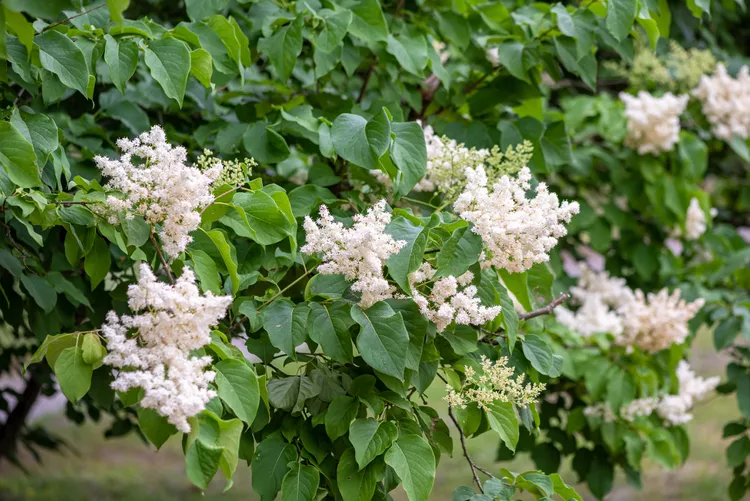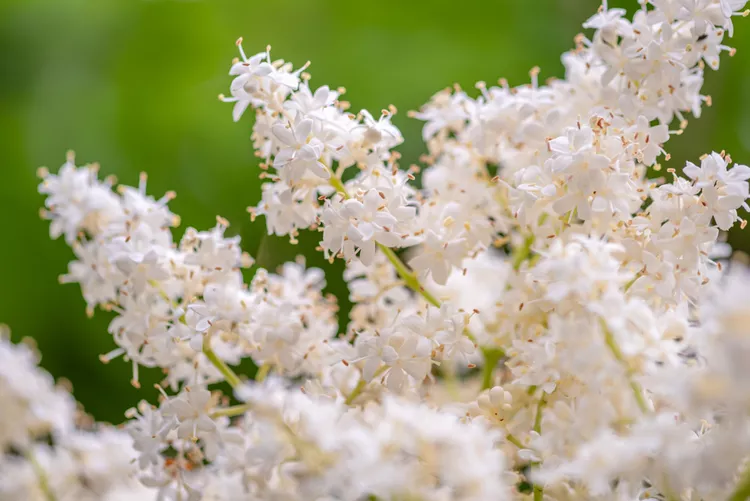| Common Name | Ivory silk lilac |
| Botanical Name | Syringa reticulata ‘Ivory Silk’ |
| Family Name | Oleaceae |
| Plant Type | Tree or large shrub |
| Mature Size | 20-30 ft. tall, 15-20 ft. wide |
| Sun Exposure | Full sun |
| Soil Type | Clays, sandy loams, well-draining |
| Soil pH | Neutral |
| Bloom Time | Summer |
| Flower Color | White |
| Hardiness Zones | 3-7 (USDA) |
| Native Area | Japan |
Ivory Silk Lilac Care
Here are the basic requirements to grow ivory silk lilac.
- Plant in full sun.
- Place in any type of soil as well as it is well-draining.
- Water a young ivory silk lilac weekly during the growing season, but it will become drought-tolerant as it matures.
- Prune in the winter before its growth period.

Light
This tree needs full sun. A partially sunny or shaded location reduces the number of flowers. If it is in a sunny spot, your tree will explode with huge white clusters of blooms.
Soil
An appealing aspect of the ivory silk lilac is its ability to grow in poor soil conditions and even where soil may be rocky or compressed. The ideal soil is average, rich in organic material, well-draining, and neutral to slightly alkaline.
Water
Ivory silk lilac is somewhat drought tolerant. However, in extremely dry weather, the tree appreciates supplemental water.
Water a young tree for the first two seasons to establish a strong root system and apply a layer of mulch around the base of the tree out to the drip line. Water a newly planted tree weekly at a rate of a gallon per trunk diameter at chest height.
Temperature and Humidity
Ivory silk lilac is not especially cold-hardy though it will only thrive in the limited and cooler USDA ranges of zones 3 through 7. However, it will not do well in hot, humid climates.
Fertilizer
Applying a yearly feeding of a general extendedslow-release fertilizer formulated for ornamental flowering trees is recommended to help keep your ivory silk lilac in shape. Applying the fertilizer lightly in the spring once frost has passed should keep your tree happy and encourage plenty of blooms and foliage.
Types of Ivory Silk Lilac Trees
‘Ivory Silk’ is just one unique cultivar of Syringa reticulata. Many cultivars of the species look different from ‘Ivory Silk’ with varying traits, including:
- Syringa reticulata’ Chantilly Lace’: This multi-stemmed cultivar has creamy yellow variegated leaves.
- Syringa reticulata ‘Summer Snow’: This is a small cultivar with a compact form but with very large flower clusters.
- Syringa reticulata ‘Summer Storm’: This cultivar is known for its fast growth and is considered slightly more hardy in colder weather.
Pruning
After a few years, it is normal for an ivory silk lilac to produce fewer blooms. Maintenance pruning rejuvenates the tree and encourages new growth. Trim away 13 of your tree’s largest stems. Prune annually while the tree is dormant and before new growth appears.
Common Pests and Plant Diseases
The ivory silk lilac is not bothered by many insects. Borers may annoy the tree but it is not a serious problem. However excessive boring into the branches may weaken them and they will break off. Prevent infestation by keeping your tree stress-free with water and regular fertilizing in overly dry weather. If borers attack, remove the infested, damaged branches and dispose of them responsibly.
Several diseases can affect the species, such as bacterial blight (a common concern for white-flowered cultivars). Blight is especially prevalent during wet weather and when over-fertilizing with nitrogen-heavy fertilizers. Verticillium wilt is a concern, but proper fertilizing and proper tool sanitation are the best ways to avoid this problem.
How to Get Ivory Silk Lilac to Bloom
Bloom Months
Ivory silk lilac blooms in the summer months of June and July. The bloom period is short, however, lasting a couple of weeks.
What Do Ivory Silk Lilac Flowers Look and Smell Like?
Ivory silk lilac produces panicles of creamy white blossoms but they do not have much of a scent.
How to Encourage More Blooms
Ivory silk lilac trees need a location in full sun to produce an abundance of blooms.
Deadheading Ivory Silk Lilac Flowers
Deadhead faded flowers to encourage more growth and blooming.

Common Problems With Ivory Silk Lilac
Ivory silk lilac has minimal upkeep as long as it’s placed in the right spot. Even though, no plant is immune to every problem so keep an eye out for a couple of signs that may need to be addressed.
Wilting Flowers
Wilting flowers may indicate too much fertilizer or nitrogen in the soil.
Leaf Drop
Defoliation may occur on ivory silk lilac trees planted in too much shade. The trees may be afflicted by powdery mildew, which can cause leaf drop.
Black Spots on Leaves
If the tree has bacterial blight, black spots or stripes may also appear on leaves and stems. Leaves will turn black and die. Wet weather causes this problem. Thin out extra shoots in the tree to give the plant air circulation.
FAQ
-
-
How large will an ivory silk lilac tree grow? The ivory silk lilac can grow up to 30 feet tall with a medium growth rate of about 12 to 18 inches a year. Control the plant’s height by trimming it after the flowers bloom.
-
-
-
Do ivory silk lilac trees have a fragrance? The ivory silk lilac tree does not have much of a fragrance and it does not have a scent like other lilac trees.
-
-
-
Are the roots of an ivory silk lilac tree aggressive? No, ivory silk lilac tree roots are not aggressive or invasive, and there is no problem planting them near foundations as they will not cause any damage.
-
